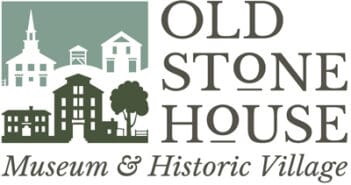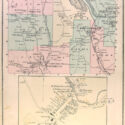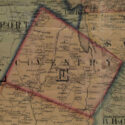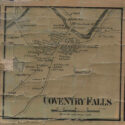Town Facts:
- Charter granted: to Maj. Elias Buel and 59 others
- First settlers: Samuel Cobb and son Tisdale Cobb, 1800
- First public roads: 1805
- Named after Coventry, Connecticut, Buel’s hometown
- Name was officially Orleans from Nov. 1841 to November 1843, in hope that it would become a shire town.
- Jabez Fitch purchased Coventry in 1801 and sold land to the first settlers Cobbs and some of the other settlers who followed them came from Westmoreland, N.H.
- Jabez Fitch built the second sawmill in town in 1803 on the upper falls of the Black River.
- Coventry Gore, south of Newport, and Buel’s Gore in Chittenden County were granted to meet the requirement that townships be six square miles in area.
- Coventry Gore was first settled in 1825 by Archibald W. Higgins.
- “Coventry Leg” area became part of Newport in 1816.
- Cleveland Air Service (1921-1923) was the beginning of Newport airport. Newport Municipal Airport was dedicated in 1945, and became a state airport in 1966.
Town History
From the Vermont Historical Gazetteer, edited by Abby Maria Hemenway. Orleans County – Coventry Chapter: By Rev. Pliny H. White. Published by Claremont Manufacturing Co, 1877. Pgs 136-138
Coventry is an irregular quadrangle, no two sides being of equal length; and is bounded N. E. (6.25 miles) by Newport and Salem, S. E. (4.75 miles) by Brownington, S. W. (5.75 miles) by Irasburgh, and N. W. (4.5 miles) by Newport.
The charter was granted Nov. 4, 1780, to Maj. Elias Buel and 59 others. Its boundaries as defined by the charter, were as follows:
“beginning at a beech tree, marked ‘Irasburgh corner, Sept. 26, 1778,’ being the northwesterly corner of Irasburgh, and running north 36 degrees east, six miles and 63 chains, to Lake Memphremagog; then south-easterly on the shore of said lake, about 27 chains to hemlock tree, marked ‘Salem Line, 1778;’ then south 45 degrees west, two miles and two chains, to a great hemlock tree, marked ‘Salem West Corner, Sept. 30, 1778;’ then south 45 degrees east, six miles and 21 chains, in the southerly line of Salem, to a stake five links north-west from a cedar tree, marked ‘Coventry Corner;’ then south 36 degrees west, four miles and four chains, to the North line of Irasburgh; then north 54 degrees west, five miles and four chains to the North line of Irasburgh; then north 54 degrees west, five miles and 60 chains, to the bounds began at.”
Within these limits were supposed to be contained 16,767 acres, or about 26 1-5 square miles. To make up the six square miles usually included in a township, there were granted 2000 acres directly south of Newport, called Coventry Gore, and 4273 acres in Chittenden Country, east of Starksboro, called Buel’s Gore. The north part of Buel’s gore was annexed to Huntington in 1794. That part of the town which bordered on Lake Memphremagog, being in the form of a slip, 108 rods wide on the Lake, and 2 miles, 4 rods long, was called Coventry Leg, somewhat inappropriately, as it was narrowest where it joined the body of the town, and widened as it extended north. In 1816 it was annexed to Newport. Five rights were reserved by the charter, one for the benefit of a college in this State, one for the benefit of a county grammar school, one for the benefit of schools in town, one for the first settled minister, and one for the support of the ministry as the inhabitants should direct. Buel, the principal agent in procuring the charter, was a native and resident of Coventry, Ct., and, in honor of his birth place, the same name was given to the new township.
At the time of the chartering of Coventry, and for many years after, Orleans County was destitute of inhabitants, and inaccessible by roads, and lands were of no value except for speculative purposes. Buel purchased the rights of his associates, one by one, as he had the opportunity, paying from £5 to £20, and in a few instances as much as £30 for each right; until, in 1788, the title of 54 of the 60 rights was vested in him. His deeds, however, were not put on record until 1801, and, in the mean time, sales for taxes, and levies of executions against the original proprietors had created conflicting titles to much of the land. In 1791 all the lands in town were sold by Stephen Pearl, Sheriff of Chittenden County, to satisfy a land tax of half a penny an acre levied by the Legislature of Vermont. Ira Allen purchased most of them, and 49 rights, which were not redeemed within the prescribed time, were deeded to him. Buel afterwards quitclaimed to Allen his interest in those rights, and appears to have little or no more to do with the township.
Allen made few, if any sales of his Coventry lands till 1798. In March of that year he was in London, where he met Stephen Bayard, of Philadelphia, and sold him the 2000 acres comprised in Coventry Gore for the round sum of £1600 sterling, ($7104). There is something ludicrous in the minute particularity of English forms of conveyancing [sic] as exhibited in the deed 6 pages long, by which Allen transferred these 2000 acres of woods and mountains, “together with all and singular houses, outhouses, edifices, buildings, paths, passages, commons, fishing places, hedges, ditches, gates, stiles, fences, ways, waters, water-courses, lights, liberties, casements, privileges, profits, commodities, advantages, hereditaments, and appurtenances whatsoever.” If Bayard paid the purchase money, or any part of it, it was a dead loss to him, for in the following July a direct land-tax was assessed by the Congress of the United States to satisfy which, the whole town of Coventry, including the Gore, was sold at auction at the house of Thomas Tolman, in Greensboro, May 20, 1801, by James Paddock, of Craftsbury, the collector, for $4.80, and was never redeemed. Jabez G. Fitch, of Vergennes, was the purchaser. Fitch bought the interests of all the rights, and Dec. 14, 1801, he took a conveyance of Ira Allen’s entire title. By these means he became the ostensible owner of the whole township, and had a valid title to nearly all of it.
It was by Fitch’s agency that the settlement of the town was affected. He offered land at moderate prices to actual settlers, promising gifts of land to some, (which promises, however, were fulfilled in few, in any instances,) and encouraged emigration as much as possible. Two dollars an acre was the current price of land, with a liberal credit, and cash was seldom required. Most of the early purchasers made their payments in “good clean wheat” or “merchantable neat cattle, (bulls and stags excepted,) not exceeding eight years old.” In many of the conveyances he reserved to himself “two thirds of the iron ore being and growing on the land,” a reservation which never proved of any value. Notwithstanding the pains he took to purchase all outstanding claims, the titles to some of the lands afterwards proved defective, and subjected his grantees to serious loss.
In 1799, Samuel Cobb and his son Tisdale visited the township with a view to settlement, decided to settle there, put up a log-house, and returned for their families. In March 1800, the first settlement of Coventry took place. The pioneer settlers were Samuel Cobb and Tisdale Cobb, father and son: Samuel accompanied by his children, Samuel, Jr., Nathaniel and Silence; and Tisdale by his wife. They came from Westmoreland, N. H., May 15th, traveling on horseback as far as Brownington, which being the end of the road, they left their horses there and made their way on foot through the dense woods, marking the trees as they went till they reached the east part of Coventry, March 27th. Samuel Cobb pitched on lot No. 11, now occupied by Stillman Church, and built a log-cabin directly opposite the present site of Mr. Church’s house. Tisdale Cobb pitched on lot No. 12, now occupied by Jesse Miller, and built a cabin just east of the present grave-yard. Samuel Cobb, Jr., made an opening on lot 6, now owned by James K. Blake, but, being disappointed in some of Fitch’s promises, he did not locate permanently.
The cabins of these first settlers were exceedingly rude in appearance; built of spruce logs hewn only on the inside, and pointed with mud and moss, roofed with bark, having one door and one or two small windows, and inclosing only a single room, which was made to answer all the purposes of kitchen, dining-room, bedroom and parlor. Boards were not to be procured nearer than Barton, where Gen. Wm. Barton, the founder of that town, had, in 1796, built a saw-mill. From that mill, boards sufficient to floor the cabins were drawn a distance of 10 miles through the pathless woods. In the following June, Samuel Cobb’s wife (Silence Barney, born Feb. 21, 1756) and his younger children, who had remained in Westmoreland while preparations were making for their reception, joined the husband and father in the wilderness, and the first settlement of Coventry was made complete.
Tisdale Cobb’s family consisted only of himself and wife, (Sarah Pierce,) and Samuel’s of himself, his wife, 3 sons and 4 daughters. Until the arrival of Mrs. Cobb, the first comers had no baking apparatus whatever, and were obliged to go to Mr. Newhall’s in Brownington, about a mile, to do all their baking. Silence Cobb was usually the messenger on these errands, and had as her constant companion through the lonely woods, a large black dog, which, being a very docile animal, she taught to do pack horse duty, in carrying to and fro on his back the bags of meal or of bread.
All the first settlers, male and female, were of more than usual physical ability; and being of athletic frames and rugged constitutions, were admirably qualified to endure the hardships of a settlement in the wilderness. Hardships they had to endure, and those neither few nor small. It was no light task to conquer the primeval forest, nor was it easy even to procure needful food for themselves and their animals while the work of clearing was going on.



